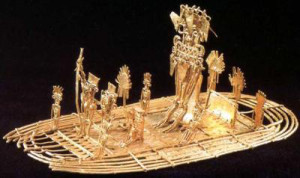
This wonderful piece, the best example of a votive figure (offering), measures 19,5 centimeters long by 10,1 wide and 10,2 high. The piece has been made in the late period of the Muisca culture, between 1200 and 1500 AD
In the center of the piece is a character of great importance and outstanding size who is interpreted as the chief. The central figure is surrounded by twelve other minor characters.
Some carry sticks, those in the front carry two jaguar masks and shaman maracas in their hands and in the very small ones, who are on the edge of the raft, the rowers can be recognized.
The Muisca Raft was found in a cave, in the Pasca goldsmiths municipality, south of Bogotá, in 1856 by three peasants, among other numerous gold objects. It was inside a ceramic container in the shape of a shaman sitting in a thinking position, his hand on his chin.
When the rumor of the find spread in Pasca, the local priest immediately understood its importance as a heritage and undertook his defense of illegal exportation and foundry.
I'm gay but it's important